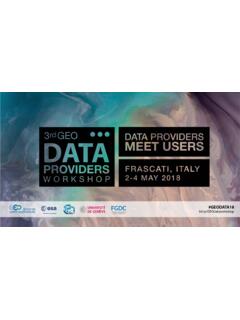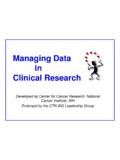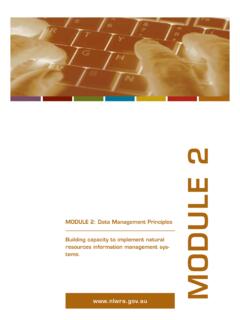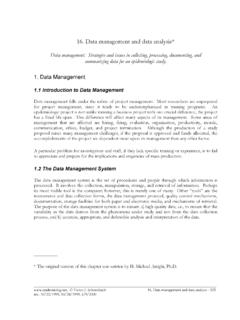Transcription of OPEN Comment: The FAIR Guiding Principles for scientific ...
1 Comment: The FAIR GuidingPrinciples for scientific datamanagement and stewardshipMark D. Wilkinsonetal.#There is an urgent need to improve the infrastructure supporting the reuse of scholarly data . A diverseset of stakeholders representing academia, industry, funding agencies, and scholarly publishers havecome together to design and jointly endorse a concise and measureable set of Principles that we referto as the FAIR data Principles . The intent is that these may act as a guideline for those wishing toenhance the reusability of their data holdings. Distinct from peer initiatives that focus on the humanscholar, the FAIR Principles put specific emphasis on enhancing the ability of machines to automaticallyfind and use the data , in addition to supporting its reuse by individuals.
2 This Comment is thefirstformal publication of the FAIR Principles , and includes the rationale behind them, and some exemplarimplementations in the discovery through good data managementGood data management is not a goal in itself, but rather is the key conduit leading to knowledgediscovery and innovation, and to subsequent data and knowledge integration and reuse by thecommunity after the data publication process. Unfortunately, the existing digital ecosystemsurrounding scholarly data publication prevents us from extracting maximum benefitfromourresearch investments ( , ).
3 Partially in response to this, science funders, publishers andgovernmental agencies are beginning to require data management and stewardship plans for datagenerated in publicly funded experiments. Beyond proper collection, annotation, and archival, datastewardship includes the notion of long-term care of valuable digital assets, with the goal that theyshould be discovered and re-used for downstream investigations, either alone, or in combination withnewly generated data . The outcomes from good data management and stewardship , therefore, arehigh quality digital publications that facilitate and simplify this ongoing process of discovery, evaluation,and reuse in downstream studies.
4 What constitutes good data management is, however, largelyundefined, and is generally left as a decision for the data or repository owner. Therefore, bringing someclarity around the goals and desiderata of good data management and stewardship , and definingsimple guideposts to inform those who publish and/or preserve scholarly data , would be of great article describes four foundational Principles Findability, Accessibility, Interoperability, andReusability that serve to guide data producers and publishers as they navigate around theseobstacles, thereby helping to maximize the added-value gained by contemporary.
5 Formal scholarlydigital publishing. Importantly, it is our intent that the Principles apply not only to data in theconventional sense, but also to the algorithms, tools, and workflows that led to that data . Allscholarly digital research objects2 from data to analytical pipelines benefit from application ofthese Principles , since all components of the research process must be available to ensuretransparency, reproducibility, and are numerous and diverse stakeholders who stand to benefit from overcoming these obstacles:researchers wanting to share, get credit, and reuse each other s data and interpretations; professionaldata publishers offering their services.
6 Software and tool-builders providing data analysis andprocessing services such as reusable workflows; funding agencies (private and public) increasinglyCorrespondence and requests for materials should be addressed to (email: full list of authors and their affiliations appears at the end of the CATEGORIES Research data PublicationcharacteristicsReceived:10 December2015 Accepted:12 February2016 |3:160018| with long-term data stewardship ; and a data science community mining, integrating andanalysing new and existing data to advance discovery.)
7 To facilitate the reading of this manuscript bythese diverse stakeholders, we provide definitions for common abbreviations in Box1. Humans,however, are not the only critical stakeholders in the milieu of scientific data . Similar problems areencountered by the applications and computational agents that we task to undertake data retrievaland analysis on our behalf. These computational stakeholders are increasingly relevant, and demandas much, or more, attention as their importance grows. One of the grand challenges of data -intensivescience, therefore, is to improve knowledge discovery through assisting both humans, and theircomputational agents, in the discovery of, access to, and integration and analysis of, task-appropriatescientific data and other scholarly digital certain types of important digital objects, there are well-curated, deeply-integrated,special-purpose repositories such as Genbank3, Worldwide Protein data Bank (wwPDB4), andUniProt5in the life sciences.
8 Space Physics data Facility (SPDF; ) and Set ofIdentifications, Measurements and Bibliography for Astronomical data (SIMBAD6) in the spacesciences. These foundational and critical core resources are continuously curating and capturing high-value reference datasets andfine-tuning them to enhance scholarly output, provide support for bothhuman and mechanical users, and provide extensive tooling to access their content in rich, dynamicways. However, not all datasets or even data types can be captured by, or submitted to, theserepositories.
9 Many important datasets emerging from traditional, low-throughput bench science don tfit in the data models of these special-purpose repositories, yet these datasets are no less importantwith respect to integrative research, reproducibility, and reuse in general. Apparently in response tothis, we see the emergence of numerous general-purpose data repositories, at scales ranging frominstitutional (for example, a single university), to open globally-scoped repositories such as Dataverse7,FigShare ( ), Dryad8, Mendeley data ( ), Zenodo ( ), DataHub ( ), DANS ( ), and EUDat9.
10 Suchrepositories accept a wide range of data types in a wide variety of formats, generally do not attemptto integrate or harmonize the deposited data , and place few restrictions (or requirements) on thedescriptors of the data deposition. The resulting data ecosystem, therefore, appears to be movingaway from centralization, is becoming more diverse, and less integrated, thereby exacerbating thediscovery and re-usability problem for both human and computational example of these obstacles could be imagined in the domain of gene regulation and expressionanalysis.



















